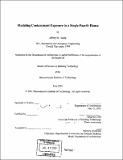| dc.contributor.advisor | Qingyan Chen. | en_US |
| dc.contributor.author | Huang, Jeffrey M., 1977- | en_US |
| dc.contributor.other | Massachusetts Institute of Technology. Dept. of Architecture. | en_US |
| dc.date.accessioned | 2011-12-09T21:20:32Z | |
| dc.date.available | 2011-12-09T21:20:32Z | |
| dc.date.copyright | 2001 | en_US |
| dc.date.issued | 2001 | en_US |
| dc.identifier.uri | http://hdl.handle.net/1721.1/67537 | |
| dc.description | Thesis (S.M.)--Massachusetts Institute of Technology, Dept. of Architecture, 2001. | en_US |
| dc.description | Includes bibliographical references (p. 144-146). | en_US |
| dc.description.abstract | New, stricter building codes for energy conservation mandates tighter building construction, which directly reduces the amount of available fresh air from infiltration. This decrease in fresh air is a subject of intensive study as health becomes a progressively sensitive issue. Mechanical ventilation is a system increasingly implemented to respond to and aid these burgeoning trends to reduce the risk of overexposure to indoor pollutants. In this study, occupational exposure to household contaminants in a single-family house with several ventilation, heating, and climactic conditions was simulated using CFD. Typical household exposure to CO2, CO, HCHO (formaldehyde), NO2, and water vapor is evaluated over the day for a generic occupational schedule of four family members, consisting of a mother, father, son, and daughter. The ventilation types included a bimodal, relative humidity controlled, and balanced system, coupled with either room convectors, or a combination of a heated floor and room convectors. Both the winter and summer conditions were considered to the drastic difference in outdoor conditions, as well to isolate the effects of the heating system. Characteristically, high degrees of thermal and contaminant stratification were found during the winter months, where low infiltration rates mimic displacement ventilation. This leads to lower contaminant exposure due to a lower concentration reservoir of air below the breathing zone. Entrainment of this air to the breathing region results in lower exposure. Also, it is found that the stratification effect is more efficient at curbing exposure than increasing the global ventilation rate for the cases evaluated. Door positions play a key role in the mitigation of contaminant migration throughout the house. In addition, the centralized location of the exhaust devices draws contaminated air from the periphery of the house radially inward to the core, where the occupants are less likely to be during the day. The period of sleeping greatly dictates the overall exposure to bioeffluents, as this is the activity in which the family partakes for the greatest percentage of time they are at home. | en_US |
| dc.description.statementofresponsibility | by Jeffrey M. Huang. | en_US |
| dc.format.extent | 146 p. | en_US |
| dc.language.iso | eng | en_US |
| dc.publisher | Massachusetts Institute of Technology | en_US |
| dc.rights | M.I.T. theses are protected by
copyright. They may be viewed from this source for any purpose, but
reproduction or distribution in any format is prohibited without written
permission. See provided URL for inquiries about permission. | en_US |
| dc.rights.uri | http://dspace.mit.edu/handle/1721.1/7582 | en_US |
| dc.subject | Architecture. | en_US |
| dc.title | Modeling contaminant exposure in a single-family house | en_US |
| dc.type | Thesis | en_US |
| dc.description.degree | S.M. | en_US |
| dc.contributor.department | Massachusetts Institute of Technology. Department of Architecture | |
| dc.identifier.oclc | 49555015 | en_US |
